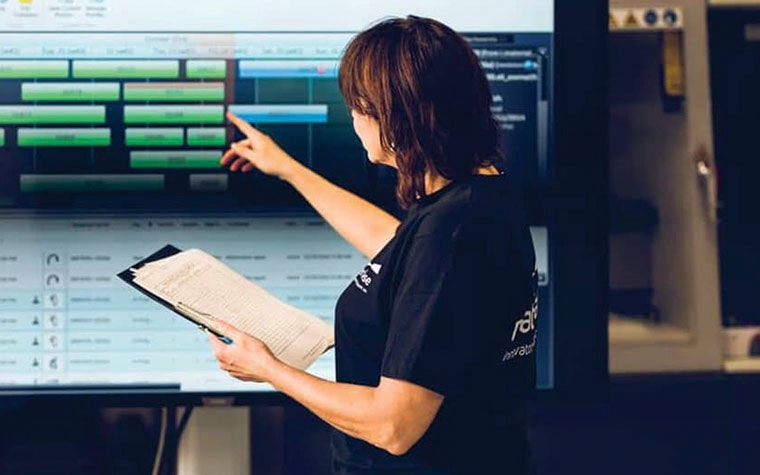EXPERT INSIGHT
Chains That Change the World

In uncertain times, unpacking traditional approaches in manufacturing can enable a mind-set shift. Agility and fresh thinking are key, as is understanding variables to anticipate what will drive the next waves of growth.
For those looking to stay ahead of the curve, becoming more sustainable and identifying new business models may help uncover new revenue streams and work around resistance.
Sustainable supply chains
Businesses that are looking to future-proof their operations understand the imperative of becoming sustainable, both in environmental and economic terms. This means reducing waste and costs, while producing responsibly. Two factors are essential:
By digitizing the supply chain, companies can more easily and effectively predict and serve customer needs. By decentralizing manufacturing, it becomes possible to produce what is needed, where it’s needed, when it’s needed.
Lower set-up costs, shorter production cycles
Not only can on-demand production help reduce waste, it may also decrease total cost of ownership for businesses, by enabling leaner operations and eliminating stock risk.
Having a digital warehouse cuts out costs for physical warehousing and while 3D design files can be sent from anywhere in the world, printing parts locally can significantly reduce transportation costs whilst ensuring that parts are delivered faster.
For sectors such as aircraft maintenance and retrofitting, for example, additive manufacturing (AM) limits set-up costs and shortens production cycles. “3D printing lets us pick parts from a virtual shelf,” says Volker Liedloff, Head of Interior Engineering at 328 Support Services. “We no longer run the risk of produced spare parts becoming obsolete too soon, or of keeping tools for parts with very low demand.”
“By digitizing warehouse, organizations don’t only save on logistical costs, they can also serve their customers faster and in a more flexible way.”
— Volker Liedloff, Head of Interior Engineering, 328 Support Services
AM software to power productivity & connectivity
As digitized processes become more automated, optimized, and application-specific, they are able to guarantee increased productivity. The key to ensuring that all steps within this process are interlinked – from ordering, to planning, to production – is seamless connectivity between systems like ERP software and production management tools. In this way, supply chain managers and operators have a holistic view of and full control over their manufacturing ecosystem.


This integration can extend beyond one physical factory — the smart factory of the future is connected to a bigger system that can span the globe, retrieving data and information from wherever it is needed. Software such as Materialise Streamics is designed to manage, connect, and streamline AM technologies and digital systems, ensuring full traceability even when integrated into very large ecosystems.
Part of the full control that digital processes empower is the capability to better protect IP. As an element of Digital Rights Management (DRM), data files are encrypted during the digital process, to ensure that the right people can access the files from the right place using the right technology.
New needs, new skill sets, new business models
When it comes to transforming consumer habits in the consumer goods industry, mass customization is changing the way in which users interact with end-use products — and with brands at large. In healthcare, mass personalization is leading to better treatments for patients.
The example of the wearables industry shows how adopting a business model centered around producing on demand and close to market encourages sustainability and reduces fast fashion. For consumers, mass customization of wearables means being able to enjoy products that are more tailored to their needs, both in terms of fit and form. For the manufacturers, being asset-light has several advantages as well, notably not having the bottleneck of disrupted trade corridors.


For apparel and wearables manufacturers, setting up distributed manufacturing networks and/or adopting a profitable mass customization strategy is the way forward for catering to tomorrow’s customers. This can in turn enable businesses to add more value for the consumer and thus raise pricing, but also have a more targeted approach as they enter niche markets.
“AM allows us to react better to changing market needs. ”
— Félix España, Global New Media Manager, HOYA Vision Care
Start-ups and businesses have shown the potential high winnings of tapping into automation and data analytics that enable made-to-order production cycles. As companies innovate and pivot to reflect more nuanced market demands, they will want to invest in short production runs — something AM has proven to drastically reduce time and costs for. The pay off? Less overstock and more just-in-time production runs.
Customer stories: How AM is changing chains


Phits
Phits, an insole manufacturer, has built a system that automates the creation of customized insoles based on an individual’s foot. These 3D-printed insoles are not only made-to-measure for a user’s unique physiognomy, the person’s dynamic gait is also analyzed. Materialise design automation and product management software power the integrated, digital design and production process that is both sustainable and efficient. The digitized workflow enables DRM, which in turn means that the Phits designs are protected in that files can only be printed on machines running a specific printing technology.


Phonak
When hearing aid specialists Phonak teamed up with Materialise to discover how 3D printing could provide an alternative to traditional manufacturing, the change was fast and irreversible. Within 500 days, over 90% of hearing aid manufacturers in the USA switched to additive manufacturing.
Share on:
You might also like
Never miss a story like this. Get curated content delivered straight to your inbox.
